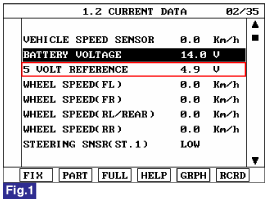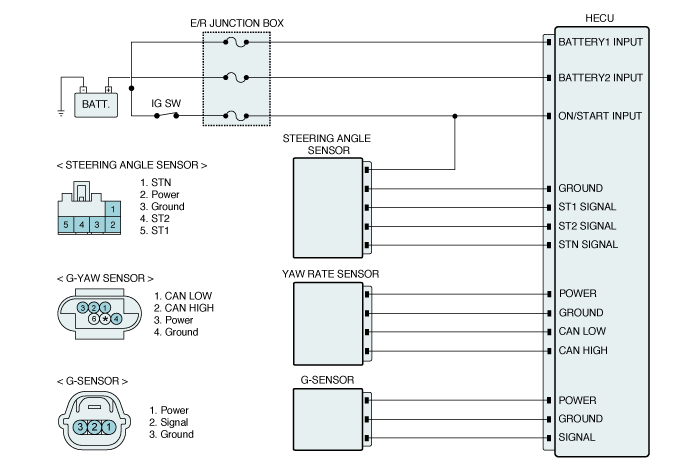Monitor the "BATTERY VOLTAGE, 5 VOLT REFERENCE" parameter on the scantool.
Specification :
BATTERY VOLTAGE (Approx. 10V ~ 16V)
5 VOLT REFERENCE (Approx. 5V)

Fig 1) Test Condition : Ignition "ON" & Engine "ON".
Normal Data
The HECU supplies operating voltage with Steering angle senor (12V), Yaw rate & lateral G sensor (12V), G sensor (5V).
The HECU monitors supply voltage of each sensor for normal ESP control.
If supply voltage is out of specified range ABS/ESP warning lamps are turned on and ABS/ESP controls are inhibited.
A failure is detected if the external sensor supply voltage is out of the specified range for more than the specified min. fault duration.
Item | Detecting Condition | Possible cause |
DTC Strategy | ● Battery Voltage Monitoring | ● Faulty HECU ● Poor connection in power supply circuit to sensor |
Enable Conditions | ● During sensor power ON, If the voltage of sensor power is out of the specified range for 500ms. ● During sensor power OFF, If the voltage of sensor power is out of the specified range for 500ms. | |
Fail Safe | ● ABS/ESP functions are inhibited, EBD function is allowed and the ABS/ESP warning lamps are activated. |

Connect scantool to Data Link Connector(DLC)
Ignition "ON" & Engine "ON".
Monitor the "BATTERY VOLTAGE, 5 VOLT REFERENCE" parameter on the scantool.
Specification :
BATTERY VOLTAGE (Approx. 10V ~ 16V)
5 VOLT REFERENCE (Approx. 5V)

Fig 1) Test Condition : Ignition "ON" & Engine "ON".
Normal Data
Is parameter displayed within specifications?
 | ▶ Fault is intermittent caused by poor connection in HECU's connector or was repaired and HECU memory was not cleared. Thoroughly check connectors for looseness, poor connection, bending, corrosion, contamination, deterioration, or damage. Repair or replace as necessary and then go to "Verification of Vehicle Repair" procedure. |
 | ▶ Go to "Terminal and Connector Inspection" procedure. |
Many malfunctions in the electrical system are caused by poor harness(es) and terminal condition. Faults can also be caused by interference from other electrical systems, and mechanical or chemical damage.
Thoroughly check connectors for looseness, poor connection, bending, corrosion, contamination, deterioration, or damage.
Has a problem been found?
 | ▶ Repair as necessary and then go to "Verification of Vehicle Repair" procedure. |
 | ▶ Go to "Power Circuit Inspection" procedure. |
Ignition "ON" & Engine "OFF".
Measure voltage between power terminal of the steering angle sensor, Yaw rate & lateral G sensor, G sensor harness connector and chassis ground.
Specification : Approx. 12V (steering angle sensor, Yaw rate & lateral G sensor), Approx. 5V (G sensor)
Is the measured value within specifications?
 | ▶ Substitute with a known-good HECU and check for proper operation. If problem is corrected, replace HECU and then go to "Verification of Vehicle Repair" procedure. |
 | ▶ Repair open or short in power circuit between HECU harness connector and steering angle sensor, Yaw rate & lateral G sensor, G sensor harness connector and then go to "Verification of vehicle Repair" procedure. If there is no problem in power circuit, Substitute with a known-good HECU and check for proper operation. If problem is corrected, replace HECU and then go to "Verification of Vehicle Repair" procedure. |
After a repair, it is essential to verify that the fault has been corrected.
Connect scantool and select "Diagnostic Trouble Codes(DTCs)" mode
Using a scantool, Clear DTC.
Operate the vehicle within DTC Detecting Condition in General Information.
Using a scantool, Check DTC present.
Are any DTCs present ?
 | ▶ Go to the applicable troubleshooting procedure. |
 | ▶ System performing to specification at this time. |